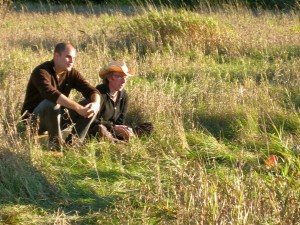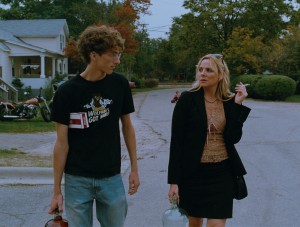 Today we are pleased to present a conversation between Keith Bearden and Jordan Horowitz, the first-time Director and first-time Producer of MEET MONICA VELOUR, starring Kim Cattrall, about what it was like to make the film, the lessons they learned, and expectations for the future. The film will premiere at the Tribeca International Film Festival on Sunday April 25th, and other screening times can be found here.–
Today we are pleased to present a conversation between Keith Bearden and Jordan Horowitz, the first-time Director and first-time Producer of MEET MONICA VELOUR, starring Kim Cattrall, about what it was like to make the film, the lessons they learned, and expectations for the future. The film will premiere at the Tribeca International Film Festival on Sunday April 25th, and other screening times can be found here.–
Keith Bearden: I have to start by saying that having done well with short films and commercials, the important parts of feature filmmaking were there when I started (when I hear about writers jumping head first into feature directing I wince in sympathy pain). But of course, there were still a lot of challenges ahead.
My biggest lesson was learning what you don’t need in a screenplay. The original shooting script had long (4+) pages of dialogue, that while good, and relevant, we wound up cutting down after we shot it. I realized that if you cast well, and you and your actors know and inhabit the characters, so much of what I was trying to make sure people understood with all that dialogue gets communicated better by the performances.
Jordan Horowitz: I think I tried to get Keith to cut some of his screenplay before we started shooting, but he wouldn’t do it. And I get why he wouldn’t do it. At the end of the day, I think it helped with character development, so while it was, in the end, cut from the film… it had a lasting effect on the film. But I think I learned how to talk to a writer/director about what is needed in a screenplay, and what is not.
KB: Also, naively, as a greenhorn I assumed that everyone working in the movie business was at least competent, if not talented and trustworthy. Not so. To some people, even people with great credits, it’s a job, and people with little perception or creativity still work their whole lives in the biz. And they are liabilities to your movie, and need to be micro-managed or weeded out.
JH: I took this same lesson to heart. Frankly, we got burned by being too trusting of crew. There is just so much management involved with production: everyone is looking for direction. And I, like Keith, give people the benefit of the doubt. Don’t get me wrong, in the long run, I still think this is a good thing and the right way to operate. It’s just a matter of going in with your eyes open and striking a balance early on.
KB: Movies become different things than you originally intended. MEET MONICA VELOUR was always intended as a dark comedy, with heart, and it still is, but the relationship that we captured, because of Dustin Ingram and Kim Cattrall’s performances, and their genuine love for each other on set, was bigger and sweeter and more dramatic than I perhaps thought of when writing it. It would have been stupid to deny audiences that, so we edited accordingly.
 JH: This film changed so many times for me. For us. So many times. I can’t even being to think what it was like for Keith, who was living with it, creatively, for so many years. We cut and recut and had different editors and then went back to the original editor… but in the end, I (and I think Keith) am really happy with the final product. We took a longer road than we’d originally intended, but we got there. We did.
JH: This film changed so many times for me. For us. So many times. I can’t even being to think what it was like for Keith, who was living with it, creatively, for so many years. We cut and recut and had different editors and then went back to the original editor… but in the end, I (and I think Keith) am really happy with the final product. We took a longer road than we’d originally intended, but we got there. We did.
KB: Also, making movies on location is lonely hard work. You have no free time, local people have their own lives, you’re away from your family and friends, the mind is totally preoccupied. It’s kind of like going to war, but without all the blood and fire and stuff.
JH: I don’t know what Keith is taking about. There was fire. And there was definitely a good amount of blood.
KB: I’m very aware of the current situation in the American movie landscape; more indie pics than ever, and more moviegoers only going to the theatre to see the in-every-multiplex-in-America-remake-of-an-80s-movie-in-3D tentpole releases. Also, when you make a movie, you should only try to make the best movie for the audience in your mind (even if it’s only you) and not try to follow trends, maximize imaginary demographics, or think too much about its outcome when it comes to your career or life. Do I think that MEET MONICA VELOUR has the audience friendly potential to be one of the few breakout indie hits? Yes. Would I be happy to be a movie that people see in fests, a handful of US theatres, and grow to dig on DVD and streaming? Also yes. My goal with MEET MONICA VELOUR is to hear audiences laugh, and talk to people or read about people who really enjoyed it. I’m happy to take it one venue at a time. Where this film winds up in the end is really out of my control, and in the hands of my producers, our sales agent, our future distributor, the press, audiences, the Gods of Cinema and other mysterious forces.
JH: As I said above, the process of this film has been a long one, with changes at every turn, and I think it has helped temper my expectations. I am fully aware of the ever-changing distribution environment for independent film. We will find a buyer for this film, and with Kim Cattrall (I think al lot of people underestimate her market appeal, by the way), there will be a theatrical play, but more importantly there will be significant value in ancillary markets. So we’ll look for a buyer who can structure a deal around a big TV or DVD or VOD component and use theatrical as, in a worst case scenario, long-lead marketing. At the end of the day, with the right campaign, this film will find its audience and really speak to people, of that I am certain.
—
The facebook page for the film is at: www.facebook.com/meetmonicavelour An exclusive clip can be found on Cinematical here.
Jordan Horowitz works at Gilbert Films with producer Gary Gilbert. While MEET MONICA VELOUR was Jordan’s first feature, Gary has produced and financed GARDEN STATE, HENRY POOLE IS HERE, and the unreleased Ken Lonergan film MARGARET. Together, they also produced Lisa Cholodenko’s THE KIDS ARE ALL RIGHT, due out for release by Focus Features on July 7th. Jordan can be found on twitter @jehorowitz
Keith Bearden’s 2005 short The Raftman’s Razor was named best short at the SXSW, Seattle, and Montreal film festivals and is in the permanent collection at MoMA. He is the recipient of Showtime’s Tony Cox Award for Screenwriting and in 2008 received a Guggenheim Fellowship for filmmaking. MEET MONICA VELOUR is his first feature film.





